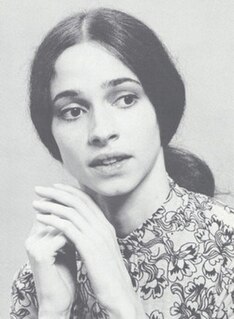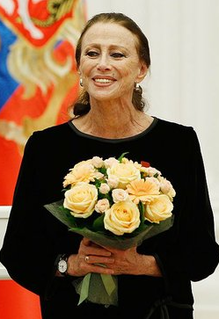 W
WPrima ballerina assoluta is a title awarded to the most notable of female ballet dancers. To be recognised as a prima ballerina assoluta is a rare honour, traditionally reserved only for the most exceptional dancers of their generation. Originally inspired by the Italian ballet masters of the early Romantic ballet, and literally meaning absolute first ballerina, the title was bestowed on a prima ballerina who was considered to be exceptionally talented, above the standard of other leading ballerinas. The title is very rarely used today and recent uses have typically been symbolic, either in recognition of a prestigious international career, or for exceptional service to a particular ballet company. There is no universal procedure for designating who may receive the title, which has led to dispute in the ballet community over who can legitimately claim it. It is usually a ballet company that bestows the title, however some dancers have had the title officially sanctioned by a government or head of state, sometimes for political rather than artistic reasons. Less common is for a dancer to become identified as a prima ballerina assoluta as a result of public and critical opinion.
 W
WAlicia Alonso was a Cuban prima ballerina assoluta and choreographer whose company became the Ballet Nacional de Cuba in 1955. She is best known for her portrayals of Giselle and the ballet version of Carmen.
 W
WEva Evdokimova-Gregori was a Prima Ballerina Assoluta with the Royal Danish, Berlin Opera Ballets, English National Ballet and guest artist with virtually every major ballet company worldwide.
 W
WAlessandra Ferri is an Italian prima ballerina. She danced with the Royal Ballet (1980–1984), American Ballet Theatre (1985–2007) and La Scala Theatre Ballet (1992–2007) and as an international guest artist, before temporally retiring on 10 August 2007, aged 44, then returning in 2013. She was eventually granted the rank of prima ballerina assoluta.
 W
WDame Margaret Evelyn de Arias DBE, known by the stage name Margot Fonteyn, was an English ballerina. She spent her entire career as a dancer with the Royal Ballet, eventually being appointed prima ballerina assoluta of the company by Queen Elizabeth II. Beginning ballet lessons at the age of four, she studied in England and China, where her father was transferred for his work. Her training in Shanghai was with George Goncharov, contributing to her continuing interest in Russian ballet. Returning to London at the age of 14, she was invited to join the Vic-Wells Ballet School by Ninette de Valois. She succeeded Alicia Markova as prima ballerina of the company in 1935. The Vic-Wells choreographer, Sir Frederick Ashton, wrote numerous parts for Fonteyn and her partner, Robert Helpmann, with whom she danced from the 1930s to the 1940s.
 W
WMathilda-Marie Feliksovna Kschessinskaya was a Polish ballerina from a Polish noble family Krzesiński. Her father Feliks Krzesiński and her brother both danced in Saint Petersburg. She was a mistress of the future Tsar Nicholas II of Russia prior to his marriage, and later the wife of his cousin Grand Duke Andrei Vladimirovich of Russia.
 W
WPierina Legnani was an Italian ballerina considered one of the greatest ballerinas of all time.
 W
WDame Margot Fonteyn, DBE, stage name of Margaret Evelyn de Arias, was an English ballerina. She spent her entire career as a dancer with the Royal Ballet, eventually being appointed Prima Ballerina Assoluta of the company by Queen Elizabeth. She joined the Vic-Wells Ballet School at the age of 14 and from 1935 was the prima ballerina of the company, which would later be called the Sadler's Wells Ballet and the Royal Ballet. In 1959, though still tied to the Royal Ballet, she was allowed to perform as a freelance dancer to enable her work as a guest dancer with various international companies. Though she officially retired in 1979, she occasionally appeared as a dancer through the late-1980s.
 W
WDame Alicia Markova DBE was a British ballerina and a choreographer, director and teacher of classical ballet. Most noted for her career with Sergei Diaghilev's Ballets Russes and touring internationally, she was widely considered to be one of the greatest classical ballet dancers of the twentieth century. She was the first British dancer to become the principal dancer of a ballet company and, with Dame Margot Fonteyn, is one of only two English dancers to be recognised as a prima ballerina assoluta. Markova was a founder dancer of the Rambert Dance Company, The Royal Ballet and American Ballet Theatre, and was co-founder and director of the English National Ballet.
 W
WMaya Mikhailovna Plisetskaya was a Soviet ballet dancer, choreographer, ballet director, and actress. In post-Soviet times, she held both Lithuanian and Spanish citizenship. She danced during the Soviet era at the Bolshoi Theatre under the directorships of Leonid Lavrovsky, then of Yury Grigorovich; later she moved into direct confrontation with him. In 1960 when Galina Ulanova, another famed Russian ballerina retired, Plisetskaya became prima ballerina assoluta of the company.
 W
WMarina Timofeyevna Semyonova was the first Soviet-trained prima ballerina. She was born in Saint-Petersburg. She was named a People's Artist of the USSR in 1975.
 W
WPhyllis Spira was a South African ballet dancer who began her career with the Royal Ballet in England. Upon returning to South Africa, she spent twenty-eight years as prima ballerina of CAPAB Ballet, a professional company in Cape Town named for the Cape Performing Arts Board. In 1984 she was named the first South African Prima Ballerina Assoluta.
 W
WGalina Sergeyevna Ulanova was a Russian ballet dancer. She is frequently cited as being one of the greatest ballerinas of the 20th century.